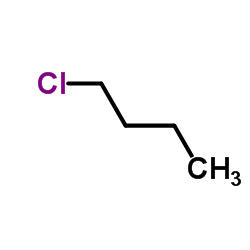1-Chlorobutane

1-Chlorobutane structure
|
Common Name | 1-Chlorobutane | ||
|---|---|---|---|---|
| CAS Number | 109-69-3 | Molecular Weight | 92.567 | |
| Density | 0.9±0.1 g/cm3 | Boiling Point | 78.2±3.0 °C at 760 mmHg | |
| Molecular Formula | C4H9Cl | Melting Point | -123ºC | |
| MSDS | Chinese USA | Flash Point | -6.7±0.0 °C | |
| Symbol |


GHS02, GHS08 |
Signal Word | Danger | |
|
Nefopam Hydrochloride: A Fatal Overdose.
J. Anal. Toxicol. 39 , 486-9, (2015) Nefopam is a non-opiate analgesic commonly used for the treatment of moderate to severe pain. A case of a 37-year-old male who was found dead in the morning is presented. An autopsy was performed and femoral venous blood, heart blood, urine, and vitreous humo... |
|
|
QSPR modeling of octanol/water partition coefficient for vitamins by optimal descriptors calculated with SMILES.
Eur. J. Med. Chem. 43 , 714-40, (2008) Simplified molecular input line entry system (SMILES) has been utilized in constructing quantitative structure-property relationships (QSPR) for octanol/water partition coefficient of vitamins and organic compounds of different classes by optimal descriptors.... |
|
|
Characterizing metabolites and potential metabolic pathways for the novel psychoactive substance methoxetamine.
Drug Test. Anal. 6(6) , 506-15, (2014) The classic approach of controlled volunteer studies to study drug metabolism is difficult or impossible to undertake for novel psychoactive substances (NPS), as there is generally very limited information available to allow appropriate dose finding and safet... |
|
|
Use of a carboxylesterase inhibitor of phenylmethanesulfonyl fluoride to stabilize epothilone D in rat plasma for a validated UHPLC-MS/MS assay.
J. Chromatogr. B. Analyt. Technol. Biomed. Life Sci. 969 , 60-8, (2014) A sensitive, accurate and rugged UHPLC-MS/MS method was developed and validated for the quantitation of Epothilone D (EpoD), a microtubule stabilizer in development for treatment of Alzeimer's disease, in rat plasma. The ester group in EpoD can be hydrolyzed ... |
|
|
Analysis of fentanyl in urine by DLLME-GC-MS.
J. Anal. Toxicol. , (2014) Fentanyl is a synthetic narcotic anesthetic ∼80-100 times more potent than morphine. Owing to the potential for its abuse, the drug may be included in a forensic toxicology work-up, which requires fast, precise and accurate measurements. Here, the stability o... |
|
|
Development and evaluation of electromembrane extraction across a hollow polymer inclusion membrane.
J. Chromatogr. A. 1406 , 34-9, (2015) In this work, a new variation of the electromembrane extraction (EME) approach employing a hollow polymer inclusion membrane (HPIM) was developed. In this method, a HPIM was prepared by casting a solution of the desired proportions of cellulose acetate (CTA),... |
|
|
Measurement of a Comprehensive Sex Steroid Profile in Rodent Serum by High-Sensitive Gas Chromatography-Tandem Mass Spectrometry.
Endocrinology 156 , 2492-502, (2015) Accurate measurement of sex steroid concentrations in rodent serum is essential to evaluate mouse and rat models for sex steroid-related disorders. The aim of the present study was to develop a sensitive and specific gas chromatography-tandem mass spectrometr... |
|
|
Haloalkane degradation and assimilation by Rhodococcus rhodochrous NCIMB 13064.
Microbiology 140 ( Pt 6) , 1433-42, (1994) The bacterium Rhodococcus rhodochrous NCIMB 13064, isolated from an industrial site, could use a wide range of 1-haloalkanes as sole carbon source but apparently utilized several different mechanisms simultaneously for assimilation of substrate. Catabolism of... |
|
|
Invoking pairwise interactions in water-promoted Diels-Alder reactions by using ionic liquids as cosolvents.
ChemPhysChem 15(14) , 3067-77, (2014) Rate constants and derived activation parameters of organic reactions in aqueous media, in particular Diels-Alder reactions, are sensitive to the presence of cosolvents in water. To enhance the solubility window of water, we introduced ionic liquids as cosolv... |
|
|
Separation of parent homopolymers from poly(ethylene oxide) and polystyrene-based block copolymers by liquid chromatography under limiting conditions of desorption--1. Determination of the suitable molar mass range and optimization of chromatographic conditions.
J. Chromatogr. A. 1392 , 37-47, (2015) We studied molar mass limits for the LC LCD separation of parent polystyrene (PS) and poly(ethylene oxide) (PEO) homopolymers from PEO/PS based block copolymers and we identified optimized chromatographic conditions. Time delays between barriers and sample in... |